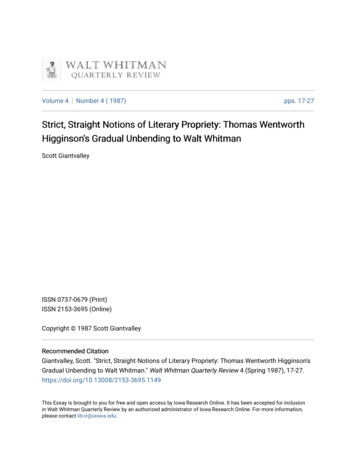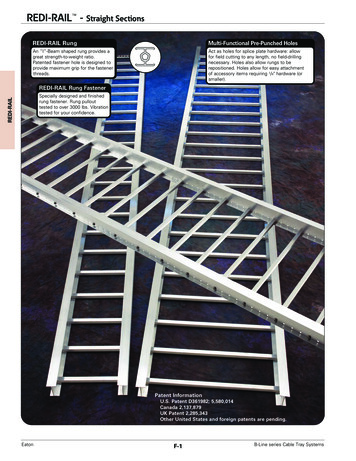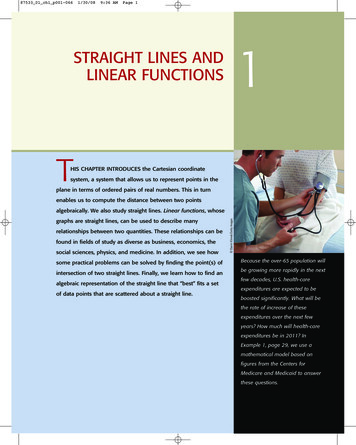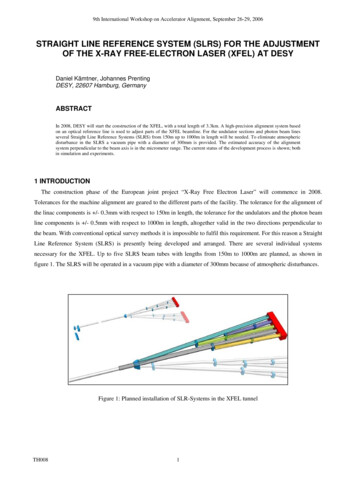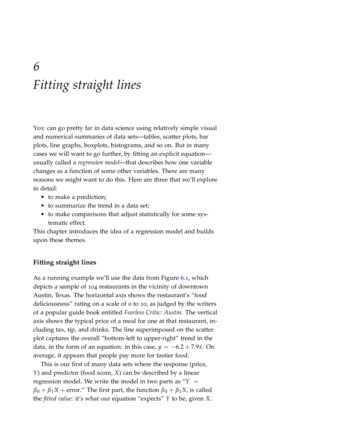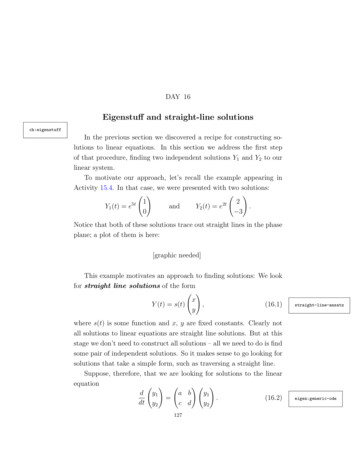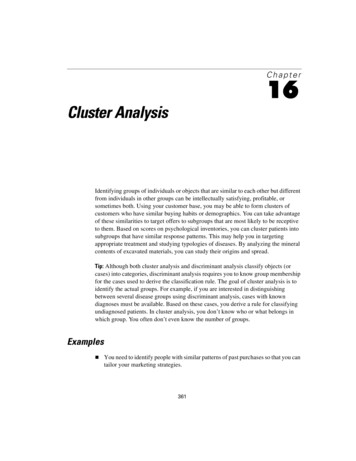
Transcription
ContentsTitle PageIntroductionPart 1. Study BasicsStep 1 Manage Your Time in Five Minutes a DayStep 2 Declare War on ProcrastinationStep 3 Choose When, Where, and How LongPart One Cheat SheetPart 2. Quizzes and ExamsStep 1 Take Smart NotesStep 2 Demote Your AssignmentsStep 3 Marshal Your ResourcesStep 4 Conquer the Material
Step 4 Conquer the MaterialStep 5 Invest in “Academic Disaster Insurance”Step 6 Provide “A ” AnswersThe Plan in ActionPart Two Cheat SheetPart 3. Essays and PapersStep 1 Target a Titillating TopicStep 2 Conduct a Thesis-Hunting ExpeditionStep 3 Seek a Second OpinionStep 4 Research like a MachineStep 5 Craft a Powerful StoryStep 6 Consult Your Expert PanelStep 7 Write Without the AgonyStep 8 Fix, Don’t FixateThe Plan in ActionPart Three Cheat Sheet
Part Three Cheat SheetConclusionAcknowledgmentsGetting in is just the beginningCopyright Page
Introduction“My friends always wonderedwhy I was never in the library,but instead in the studentcenter socializing, or at aparty, or at an event. Theysaid I made it ‘all look soeasy.’”Anna, a straight-A collegestudentThis is not your average college study guide. Unlike the
titles next to it on the shelf, none of the advice presentedhere was devised by professors or self-proclaimedacademic skills experts. I promise that you won’t find anymention of the Cornell note-taking method, mental mapdiagrams, or any other “optimal learning technique”crafted in an office or laboratory—environments farremoved from the realities of typical college life.Instead, this book reveals—for the first time—thestudy habits used by real straight-A collegestudents. All of the advice that follows was distilled froma series of interviews I conducted with a large group oftop-scoring undergraduates. These participants weredrawn predominantly from the Phi Beta Kappa rolls ofsome of the country’s most rigorous colleges anduniversities—including Harvard, Princeton, Yale,Dartmouth, Brown, Columbia, Duke, Amherst, andSkidmore—and they were carefully chosen to representa wide variety of academic concentrations. In eachinterview, I asked the student to detail his or her studyhabits. The questions ranged from the general (“How doyou defeat the urge to procrastinate?”) to the specific(“What techniques or systems do you use to locate andorganize sources for a research paper?”). If thequestionnaire revealed the student to be a grind—someone who earns high grades simply by studying anexcessive amount—I discarded the responses. I wasinterested only in students who improved their gradesthrough smarter, more efficient study skills—not through
through smarter, more efficient study skills—not throughlonger hours and more painful study sessions.How did I know such students existed? I am one ofthem. When I arrived as a freshman at DartmouthCollege, I had no idea how to prepare for exams or writecollege-level papers. Like most students, I left highschool believing that to study meant to reread your classnotes and assignments as many times as possible andthat paper writing required you to sit down in front of yourcomputer and start typing until you finished. The problem,however, is that college is not high school. The materialto be mastered is much more complicated and theprofessors have higher expectations. In the collegeenvironment, simple brute force study methods can endup requiring a lot of time and causing a lot of pain.Nevertheless, most students still rely on them. And this iswhy they find themselves regularly pulling all-nighters anddeveloping an antagonistic attitude toward their courses.The taxing effects and spotty success of these methodsalso underlie the common belief that only geniuses andgrinds can score top grades.When I first entered college, I shared in these beliefs.But soon I became dubious. It didn’t take long for me todecide that there had to be a better way to learn thematerial. The results of my studying using simpletechniques varied widely—I’d spend all night hackingaway at an essay and end up scoring a B-, or give what I
away at an essay and end up scoring a B-, or give what Ithought was a frantic last-minute review for a quiz andscore an A. I constantly felt like I was behind in myreading, and there always seemed to be new deadlineson the horizon that I had to scramble to meet. It was trulya chaotic existence. But when I looked around, all of myfriends seemed to be having the same experience—andnone of them seemed willing to question it. This didn’t sitright with me. I wasn’t content to work in long, painfulstretches and then earn only slightly above-averagegrades for my efforts. I wanted to be exceptional. And Iwanted to achieve this without having to sacrifice sleepor my social life. To many students, such a goal maysound hopelessly hubristic. But I’m an optimist by nature,and, observing the sorry state of my current study skills, Iwas convinced that I could do better.It took me most of my freshman year to construct,through repeated experimentation, a toolbox ofsufficiently improved study habits. But once I hadperfected them, the results were profound. Of the thirtysix courses I took between my sophomore and senioryears of college, I scored exactly one A- and 35 perfectAs. The most stunning piece of this transformation,however, was how much less time I had to spend onstudying. As my strategies became more refined, thehours required were reduced. By my senior year it got tothe point where, during finals periods, I would sometimespretend to be heading off to the library just so I wouldn’t
demoralize my roommates, who were preparing for yetanother grim all-nighter.What was my secret? Efficiency. The simple truth isthat the brute force techniques used by most studentsare incredibly inefficient. When it comes to exampreparation, passive review is not an effective way tolearn complicated concepts. It’s also mentally draining,which further diminishes the rate at which you canabsorb and internalize information. For paper writing,this same problem holds. When you approach the taskwithout proper preparation, it becomes incredibly tiringand you can end up spinning your wheels. After a while,even the formation of coherent sentences becomesdifficult and time intensive. In contrast, the techniques Icame up with were so streamlined that I could learn morematerial than my classmates and actually spend lesstime studying. By eliminating stupid habits and wastedeffort, I transformed exam prep and paper writing from adreaded chore to a targeted activity.For a while, I was convinced that I was unique forhaving discovered such a smart approach to learning.But, alas, this illusion was soon shattered. It occurredduring the winter of my senior year, when I was attendinga ceremony celebrating my induction, along with thirtyother classmates, into Phi Beta Kappa. This grouprepresented, more or less, the thirty students with thehighest G.P.A.s out of my class of over a thousand.
highest G.P.A.s out of my class of over a thousand.Accordingly, I had arrived at the venue prepared tospend the evening with some serious nerds. As it turnsout, however, I was in for a surprise.Upon walking through the door that night, I wasimmediately struck by how many of the other students Iknew socially. These were people who, given their levelof visibility on campus, I never would have imaginedwere scoring straight As. They were magazine editors,frat boys, and crunchy environmentalists. I knew themfrom parties and campus clubs and through mutualfriends. They were, for the most part, normal, wellrounded, and interesting—not at all the type of supergrind one might assume would occupy such an elite levelof academic achievement. The lesson of that night wasobvious: Perhaps I was not, in fact, as unique as I hadfirst imagined. Maybe there were others out there whohad discovered similar secrets to academic success.The writer instincts in me soon took over. Fascinatedto know exactly how these seemingly normal studentshad done so well, I sent all of my fellow Phi Beta Kappasa survey about their study habits. Most were happy toshare their methods and I quickly confirmed that mysuspicions were true. Not only were many of them usinginnovative, homegrown study strategies, but many ofthese strategies were surprisingly similar to those that Ihad developed during the previous few years.
had developed during the previous few years.At the time I had just finished editing the manuscript formy first book, How to Win at College, so I wasn’t exactlyeager to get started right away with another massivewriting project. But after seeing these initial surveyresponses, I knew I had stumbled onto something big.While most college students toil arduously through thestudy and paper-writing processes, there exists an elitegroup of undergrads who have discoveredunconventional strategies for earning much highergrades in much less time. I wanted to share thesesecrets with other students, and thus the idea for thisbook was born. Soon I was sending out morequestionnaires to more straight-A students at collegesaround the country, until I gathered enough responses,from students with enough different backgrounds andmajors, to distill the advice presented in this guide.In the pages that follow, you will discover the details ofthese often surprising study strategies. I’ve includedexamples and case studies throughout the book todemonstrate how to apply the advice in many differentreal-life academic situations. You will learn how to: Manage your time and deal with the urge toprocrastinate. Take targeted notes in class.
Handle reading assignments and problem sets withease. Prepare efficiently for exams. Master the art of exam-taking. Write incisive critical analysis essays. Conduct thorough research. Write standout term papers.Remember, this advice comes from real students andwas honed, through trial and error, in real collegeclassrooms. This distinction is important. It’s whatseparates this book from the many existing study guidesthat sit next to it on the bookstore shelf. As mentioned,most study guides are written either by professors oracademic skills experts, many years separated fromtheir own college experience. The result is that theauthors of these guides are disconnected from therealities of undergraduate life.For example, How to Study, by college professorsAllan Mundsack, James Deese, and Ellin K. Deese,suggests that students wake up at 7 A.M. each morning,go to sleep by 11 P.M. each night, and on many daysschedule only a single hour of “recreation,” with the restof the time dedicated to attending class, eating, orworking. One gets the feeling that these professors
working. One gets the feeling that these professorshaven’t spent much time socializing with students lately.Even their plan for Friday—the biggest party night of theweek—has the student working until 10 P.M., taking aone-hour break, then turning in by eleven.Student Success Secrets, written by Eric Jensen, alearning expert and professional public speaker, offersequally out-of-touch suggestions. His tips to help youremember concepts learned from a reading assignmentinclude “put it in a picture or poster—use intense colors,”“act out the material or do a fun role play in your ownroom,” or “create or redo a song; make a rap.” Just try toimagine a sophisticated liberal arts major attempting tomake a rap about her recent reading assignmentconcerning post-structuralist interpretations of preVictorian English literature! (Key question: What wordrhymes with “Foucault”?)The granddaddy of all unrealistic study guides,however, just might be What Smart Students Know, byPrinceton Review cofounder Adam Robinson. In thisbest-selling guide, Robinson suggests—and I swear Iam not making this up—that students approach areading assignment as a twelve-step process! That’sright, twelve separate steps. Before you even crack theactual assignment, Robinson suggests that you jot downquestions about the importance of the reading and thentake notes on what you know about the topic, what it
take notes on what you know about the topic, what itreminds you of, and what you want to learn. He then asksyou, among other things, to read the assignment a totalof three separate times, write and then rewrite yournotes, represent the information in picture form, construct“question charts,” and devise mnemonics to help youmemorize the concepts. Needless to say, this approachto a simple reading assignment is humorouslyunrealistic. I even did a little math. For a typical collegelevel liberal arts course, a student might be assigned anaverage of two hundred pages of reading a week. In hisbook, Robinson provides a one-page sample readingand describes twenty-three different questions thatstudents might ask about it. At this rate of twenty-threequestions per page, spending thirty seconds on eachquery, we would end up spending around forty hours aweek (i.e., a full-time job’s worth of time) simplycompleting one of the twelve steps on the readingassignments for just one class. Sounds like a great plan!These examples highlight the simple truth that theadvice in most existing study guides—written by“experts,” not students—is often impractical and timeconsuming. How to Become a Straight-A Student, onthe other hand, is the first guide based on theexperiences of real college students, and it was writtento provide an alternative to the other titles on the market.In the pages that follow, you will find homegrownstrategies that are compatible with the demands of your
day-to-day student life. They may not be as elaborate asthe intricate systems devised by the “experts,” but they’reeasy to implement—and they get the job done. Best ofall, when you start putting these strategies into practice,you will experience immediate results.Keep in mind: If you find a piece of advice that doesn’tquite fit your needs or circumstances, that’s okay. In fact,you should expect this. Each of the students I interviewedfo
Step 6 Provide “A ” Answers The Plan in Action Part Two Cheat Sheet Part 3. Essays and Papers Step 1 Target a Titillating Topic Step 2 Conduct a Thesis-Hunting Expedition Step 3 Seek a Second Opinion Step 4 Research like a Machine Step 5 Craft a Powerful Story Step 6 Consult Your Expert Panel Step 7 Write Without the Agony Step 8 Fix, Don’t Fixate The Plan in Action Part Three Cheat .
